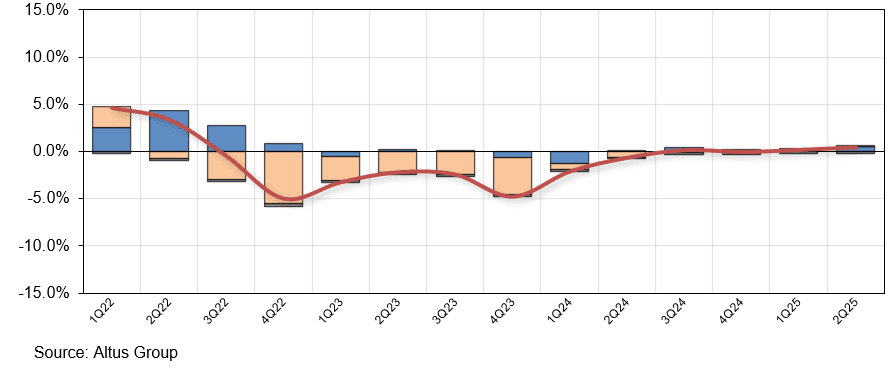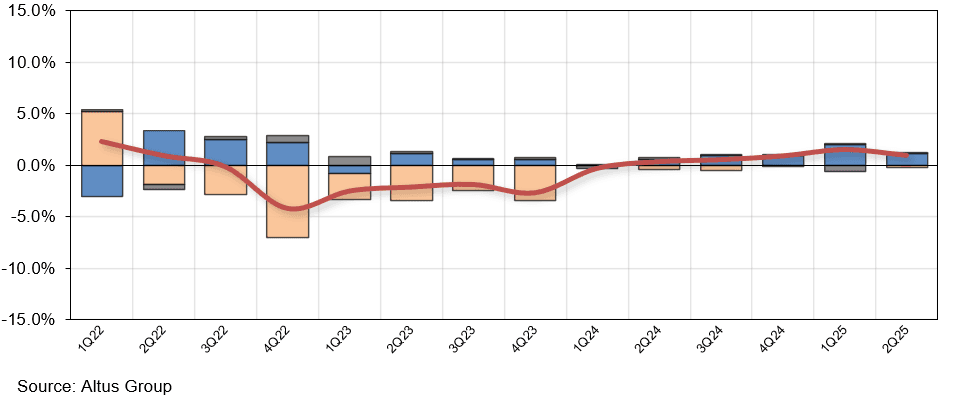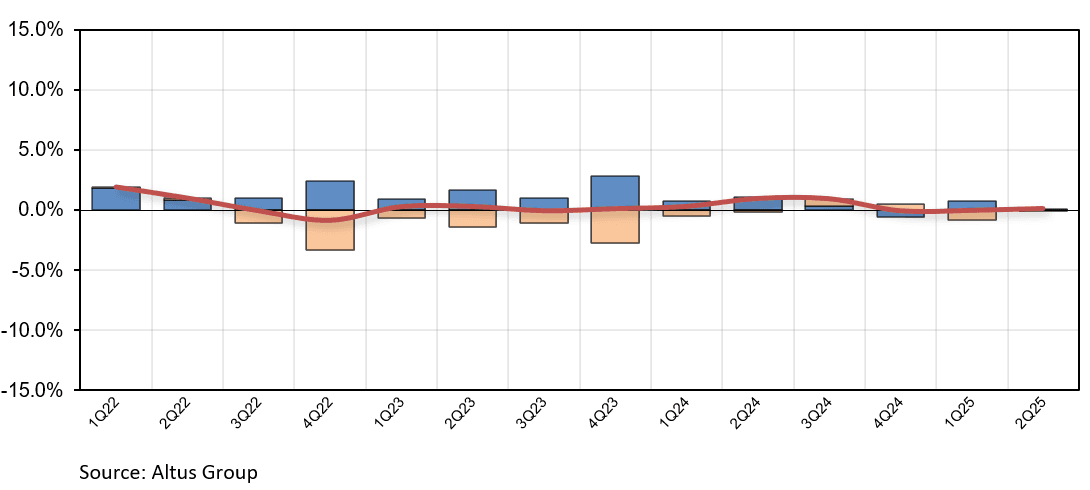CRE valuation trends - Apartment insights - Q2 2025
Global apartment valuations hold steady with resilience across regions despite supply pressures and policy shifts.

Key highlights:
The trendline for US apartments over the past 12 months has been positive, with a 0.7% increase in values that includes a 0.5% improvement in Q2 alone during which period both yield movement and cashflow gains had a positive impact on values
In Europe, residential emerged as the lead performer across the four main sectors, with values up 3.9%, built on strengthening cashflow fundamentals, which added 4.2% to values as yields began to stabilize over the course of the year
Following a year of cash flow growth, Canada is experiencing a cooling trend as vacancy levels rise
Higher construction costs are slowing new development across regions, which should benefit apartment owners in the mid and longer term
Despite challenges, apartment sector stays the course as a reliable performer
Global rental residential markets have a reputation for being resilient across market cycles, and that is once again proving out in the higher interest rate environment. Values across regions – the US, Canada, and Europe – have been on a positive trajectory over the past year, and values remained stable or slightly higher in Q2.
“The apartment market has not always been the stand-out sector, but it has been a reliable sector that has tended to trend above average over the course of the last year, but also dating back to the onset of the pandemic,” says Phil Tily, Altus Group’s Senior Vice President, Head of Performance Analytics.
The prevailing theme across regions is the supply-demand imbalance, with a lack of housing and a shortage of affordable housing in particular. That theme is especially prevalent in the US, where, despite a surge in multifamily construction over the past few years, the housing shortage is still estimated at 4 million-plus units. Although some geographic markets face near-term hurdles as they absorb new supply, high construction costs that are now slowing development are likely to benefit property owners in the medium term.
Across the board, investors continue to have a strong appetite for multifamily assets. However, there are nuances to the performance and near-term outlook when digging into regional markets. Some of the top-line trends include:
For the US, investor demand is driving positive pricing momentum with cash flows holding their own, even with supply challenges in some of the markets.
In Europe, residential has emerged as a leading sector among the four main property types, largely due to strengthening cash flows.
Canada is experiencing softening fundamentals in the wake of new supply and a slowing economy.
Below we take a closer look at the performance and outlook for each of the three regions.
US: Momentum shifts back to gateway markets
The trendline in the US for the past 12 months has been positive. During Q2, values and cash flow both increased by 0.5%, while yields held relatively firm with a slight gain of 0.2%.
The 3-year annualized value change for residential is -6.6%, which is largely a reflection of the change in the interest rate environment.
Figure 1: Q2 2025 - Appreciation return - US all sectors

Although the surge in new properties built over the past few years has been a drag on rent growth and cash flow, the excess supply is disappearing quickly. The development pipeline has also shrunk due to rising construction costs. “That declining supply is one reason that investors are still investing. Despite current supply challenges, they know that the future supply will be limited, and fundamentals will strengthen,” says Robby Tandjung, Altus Group’s Executive Vice President, Valuation Advisory.
One of the noticeable trends to highlight in the US is the power shift now occurring between the Sun Belt versus Gateway markets. The pandemic accelerated migration to the south and southeast, which resulted in a building boom and subsequent oversupply in some metros, which is now magnified by slowing population growth. Gateway markets that struggled during the pandemic are experiencing a rebound that is being driven in part by return-to-office trends. “Whether it’s New York City, Chicago, or even San Francisco, we’re seeing a rebound, especially around cash flow fundamentals,” says Tandjung.
Figure 2: Apartment Q2 2025 - One quarter appreciation attribution

Values are on the rise in most US markets. However, the data shows a stronger revival in some of the Gateway markets, with cash flow aspects of those value movements that are trending positive in Q2. “We started to see both those positive cashflow and pricing adjustments come through in Q2, and there's definitely a broader level of health associated with the apartment sector,” adds Tily.
US outlook
Apartments appear to be on an upward trajectory, and the decline in construction starts will be positive for fundamentals. However, two issues to watch in the US will be job growth and the potential privatization of Fannie Mae and Freddie Mac.
Apartments benefit from the liquidity that Fannie and Freddie provide to the market, with spreads that are relatively tight compared to other property types. Privatizing Freddie and Fannie, which have been held in government conservatorship since the GFC, is once again being discussed by the current administration. It remains unclear when privatization could occur, how it may be structured, or what impact that could have on the mortgage market.
Weakening job growth is likely a bigger near-term issue as job growth is highly correlated with renter demand. Although the unemployment rate at 4.3% reflects full employment, data shows weakening job growth in recent months, particularly among the younger cohort of 19- to 24-year-olds – a key part of the renter pool.
Europe: Strong cash flows drive higher yields
Rental residential is leading the other main property sectors in value gains over the past four quarters, with an increase of 3.9%. During Q2, the cash flow impact amounted to 1.1%, as values gained 0.9% with the yields impact tilted slightly negative at -0.2%. Compared against wider market trends, residential was less negatively impacted by the rise in interest rates. The three-year annualized value change for residential measured 3.2%, which was slightly behind the -2.9% change for retail, but better than the declines seen in both industrial and office, at -4.1% and -7.7%, respectively.
Figure 3: Q2 2025 - Appreciation return - Europe all sectors

Across Europe, rental residential is a fairly simple story of supply-demand imbalance across many major metros. “Where rental growth in other sectors, such as logistics, has tempered down and is now fairly limited, the momentum is continuing in residential,” says Nicolas Le Goff, Altus Group’s Director, Valuation Advisory for Europe. One dynamic fueling performance across Europe is that the workforce is more transient in nature, which drives greater demand for rental accommodation.
Apartments delivered the strongest cash flow performance over the past year compared to the other major property sectors, with a cashflow aspect of 4.2%, due largely to a near 4% improvement in market rents. “Over the past year, rental residential has emerged in Europe as a lead performer,” says Tily. “The strength of the sector, even more so than in the US, is coming through on the cash flow side in three of the last four quarters.”
The Netherlands market in particular has been very resilient. It’s a rent-controlled market where values have been challenging but are now starting to come off a period of decline. Although rents on existing assets have lagged market rents due to rent controls, rents also tend to be more sustainable during downturns. Additionally, owners have steadily raised rents, with particularly sharp increases over the past decade.
Europe outlook
The expectation for Q3 is that apartment valuations are likely to remain on par with Q2 values. “At the end of 2024, there was cautious optimism, and then tariffs were a bit of a cold shower that brought a lot of momentum to a standstill with very muted numbers,” says Le Goff. “Q3 results are likely to reflect a combination of the summer generally being a quiet period in Europe in terms of transactions, and investors taking more of a wait-and-see approach.”
Canada: Owners brace for softening fundamentals
Strong cash flows that apartments have generated in recent years appear to be slowing. Although values are positive on a 1-year and 3-year basis at 1.9% and 2.9%, both values and cash flows remained relatively flat in Q2 at 0.1%. New supply coming online is putting pressure on rents in most major markets across Canada in the near term.
“The expectation is over the medium to long term that will reverse, and it will again be a landlord's market, but it is a renter’s market in the largest markets in Canada,” says Robert Santilli, Altus Group’s Director of Valuation Advisory, Canada.
Figure 4: Q2 2025 - Appreciation return - Canada all sectors

Rents have moved backwards in Toronto and Vancouver, while rent growth is slowing or flat in other markets, such as Calgary and Montreal. Landlords in Vancouver and Toronto are now providing incentives to attract and retain renters, such as one to two months of free rent, free parking, and even cash up front. One of the stronger geographic markets is Calgary, which is benefiting from interprovincial migration and people relocating for higher-paying jobs in the oil & gas sector.
Like most developed countries, Canada has not been building enough housing, particularly affordable housing. “We do have a shortage, and we are really butting up against affordability issues,” says Santilli.
One trend to watch is the growing momentum behind the return-to-office trend, which may drive more relocation activity with people moving back to city centers to be closer to jobs. Of note, the Government of Ontario could set a precedent in requiring that its employees be in office five days a week by January. “We are seeing some employers require their employees to be back full time in the office, and that's going to change where people live and where developers build,” says Santilli.
Canada outlook
Historically, the rental residential market has been a very stable performer in Canada with very few periods of value decline. That being said, investors are likely going to be selective on new investments going forward due to signs of the softening in fundamentals now emerging along with slowing economic growth. The Canadian economy is feeling the effects of US tariffs and rising unemployment, which climbed to 7.1% in August.
Canada has also put policies in place that have effectively turned off the immigration tap. Immigration likely won’t pick up again until 2027, and it is unlikely to return to the same high levels as the country experienced in 2023. “We're going to be watching GDP growth and the economic health of the Canadian markets to inform on the health of the consumer,” says Santilli. “People always need a place to live, but they can only afford to pay so much, and we're likely going to see more tepid growth in the near term.”
Despite this, its expected apartments will continue to be a preferred holding by investors.
Resilience defines the rental residential outlook
Across regions, the rental residential sector continues to show stability, even as policy, cost, and supply dynamics evolve. Apartments are not always the highest-growth story, but they consistently demonstrate resilience through market cycles.
For investors and advisors, this reliability reinforces why apartments remain a cornerstone asset class. With development pipelines contracting and long-term demand drivers intact, the fundamentals point to sustained income stability and steady growth opportunities ahead.
Want to be notified of our new and relevant CRE content, articles and events?
Disclaimer
This publication has been prepared for general guidance on matters of interest only and does not constitute professional advice or services of Altus Group, its affiliates and its related entities (collectively “Altus Group”). You should not act upon the information contained in this publication without obtaining specific professional advice.
A number of factors may influence the performance of the commercial real estate market, including regulatory conditions and economic factors such as interest rate fluctuations, inflation, changing investor sentiment, and shifts in tenant demand or occupancy trends. We strongly recommend that you consult with a qualified professional to assess how these and other market dynamics may impact your investment strategy, underwriting assumptions, asset valuations, and overall portfolio performance.
No representation or warranty (express or implied) is given as to the accuracy, completeness or reliability of the information contained in this publication, or the suitability of the information for a particular purpose. To the extent permitted by law, Altus Group does not accept or assume any liability, responsibility or duty of care for any consequences of you or anyone else acting, or refraining to act, in reliance on the information contained in this publication or for any decision based on it. The distribution of this publication to you does not create, extend or revive a client relationship between Altus Group and you or any other person or entity. This publication, or any part thereof, may not be reproduced or distributed in any form for any purpose without the express written consent of Altus Group.
Authors

Robby Tandjung
Executive Vice President, Valuation Advisory

Phil Tily
Senior Vice President, Performance Analytics

Nicolas Le Goff
Director, Valuation Advisory - Europe

Robert Santilli
Director, Valuation Advisory - Canada
Authors

Robby Tandjung
Executive Vice President, Valuation Advisory

Phil Tily
Senior Vice President, Performance Analytics

Nicolas Le Goff
Director, Valuation Advisory - Europe

Robert Santilli
Director, Valuation Advisory - Canada
Resources
Latest insights






